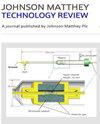8种地衣提取物对革兰氏阳性适度嗜盐细菌的抑菌效果评价
IF 2
4区 化学
Q4 CHEMISTRY, PHYSICAL
引用次数: 0
摘要
考虑到皮革部门在世界贸易中的全球经济重要性,克服微生物问题,特别是由嗜盐细菌引起的问题,将大大减少产品损失。本研究以Usnea sp.、platismatiaglauca、Ramalina farinacea、Evernia divaricata、Bryoria capillaris、Hypogymnia tubulolosa、pseudovernia furfuracea和Lobaria pulmonaria等地衣物种为研究对象,研究了它们对腐生葡萄球菌的抑菌效果。腐生菌(sprophyticus, TR5)和玫瑰盐球菌(Salinicoccus roseus, KV3),这两种细菌都是蛋白水解和脂溶革兰氏阳性的中度嗜盐细菌。青花假单胞菌、毛毛假单胞菌、糠醛假单胞菌和肺假单胞菌提取物对试验菌均无抑菌效果。另一方面,管状木犀草、粉粉木犀草、美洲木犀草和野木犀草提取物均有较好的抑菌效果,且抑菌率各不相同。在240 ~ 15µg/ml浓度下,对管状芽孢杆菌(H. tubulosa)、粉状芽孢杆菌(R. farinacea)、美国芽孢杆菌(Usnea sp .)和裂裂芽孢杆菌(E. divaricata)地衣样品中TR5的最大抑制比分别为94.72±0.75%、76.10±1.85%、99.36±0.04%、89.49±2.26%,KV3的最大抑制比分别为97.44±0.14%、95.92±0.29%、97.97±0.39%、97.58±0.53%。Usnea sp.提取物对KV3的抑制作用最显著。这些结果表明,需要进一步研究这些自然资源在生皮/皮肤保存中控制中度嗜盐细菌的适用性。本文章由计算机程序翻译,如有差异,请以英文原文为准。
Evaluation of Antibacterial Potencies of Eight Lichen Extracts Against Gram-Positive Moderately Halophilic Bacteria
Considering the global economic importance of the leather sector in world trade, overcoming the microbiological problems, especially arise from halophilic bacteria, will greatly reduce product losses. In this study, lichen species including Usnea sp., Platismatia glauca, Ramalina farinacea, Evernia divaricata, Bryoria capillaris, Hypogymnia tubulosa, Pseudevernia furfuracea and Lobaria pulmonaria were examined for their antibacterial efficacies against Staphylococcus saprophyticus subsp. saprophyticus (TR5) and Salinicoccus roseus (KV3) which are proteolytic and lipolytic Gram-positive moderately halophilic bacteria. The extracts of P. glauca, B. capillaris, P. furfuracea, and L. pulmonaria had no antibacterial efficiency against test bacteria. On the other hand, the extracts of H. tubulosa, R. farinacea, Usnea sp., and E. divaricata had considerable antibacterial effect with varying percentages of inhibition. The maximum inhibition ratios at the tested concentrations of 240-15 µg/ml for lichen samples of H. tubulosa, R. farinacea, Usnea sp, and E. divaricata were detected as 94.72±0.75%, 76.10±1.85%, 99.36±0.04%, 89.49±2.26% for TR5 and 97.44±0.14%, 95.92±0.29%, 97.97±0.39%, 97.58±0.53% for KV3, respectively. The most remarkable suppression was obtained with Usnea sp. extracts against KV3. These results indicate the need for further studies investigating the applicability of these natural resources to control moderately halophilic bacteria in the preservation of raw hides/skins.
求助全文
通过发布文献求助,成功后即可免费获取论文全文。
去求助
来源期刊

Johnson Matthey Technology Review
CHEMISTRY, PHYSICAL-
CiteScore
4.30
自引率
4.30%
发文量
48
审稿时长
12 weeks
期刊介绍:
Johnson Matthey Technology Review publishes articles, reviews and short reports on science enabling cleaner air, good health and efficient use of natural resources. Areas of application and fundamental science will be considered in the fields of:Advanced materials[...]Catalysis[...][...]Characterisation[...]Electrochemistry[...]Emissions control[...]Fine and speciality chemicals[...]Historical[...]Industrial processes[...]Materials and metallurgy[...]Modelling[...]PGM and specialist metallurgy[...]Pharmaceutical and medical science[...]Surface chemistry and coatings[...]Sustainable technologies.
 求助内容:
求助内容: 应助结果提醒方式:
应助结果提醒方式:


